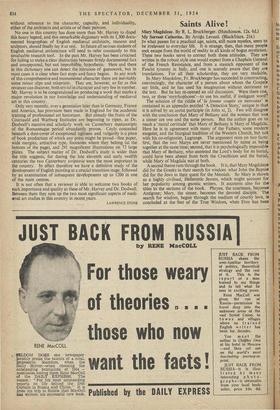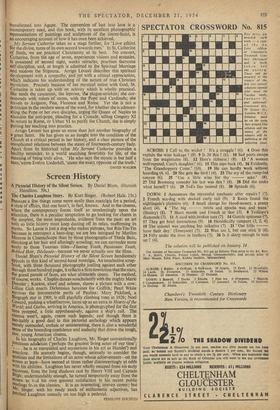Saints Alive!
Mary Magdalene. By R. L. Bruckberger. (Hutchinson. 12s. 6d.) My Servant Catherine. By Arrigo Levasti. (Blackfriars. 21s.) IN what passes for a practical age, saints, still more mystics, seem to be irrelevant to everyday life. It is strange, then, that many people seek escape from the world of reality in all kinds of bogus mysticism These two books serve to correct both these attitudes. They are written in the robust style one would expect from a Chaplain General of the French Resistance, and from a staunch opponent of the Fascist tyranny in Italy, and one is scarcely aware that they are translations. For all their scholarship, they are very readable In Mary Magdalene, Fr. Bruckberger has succeeded in constructing convincingly, the character of a person about whom the Gospels say little, and he has used his imagination without detriment to the text. But he has re-opened an old discussion. Were there one, two, or three 'myrrhophores'—to use his useful, if inelegant word?
The solution of the riddle of • la femme coupee en morceaux' is contained in an appendix entitled 'A Detective Story,' unique in that it is solved by an aorist participle (in John xi, 2). Few will disagree with the conclusion that Mary of Bethany and the woman that was a sinner are one and the same person. But the author goes on to reach a 'moral certitude' that Mary of Bethany is Mary of Magdala Here he is in agreement with many of the Fathers, some modern exegetes, and the liturgical tradition of the Western Church, but not with his co-religionist, Lagrange. The argument rests on two facts first, that the two Marys are never mentioned by name as being together at the same time; second, that it is psychologically impossible that Mary of Bethany, who anointed the Lord's body for its burial, could have been absent from both the Crucifixion and the burial, while Mary of Magdala was at both.
A second theme runs through the book. It is, that Mary Magdalene did for the Greeks in their search for wisdom what John the Baptist did for the Jews in their quest for the Messiah. So Mary is shown as a highly civilised, Hellenistic Jewess, which might account for her popularity among gnostic writers. It accounts also for the titles to the sections of the book. Phryne, the courtesan, becomes Antigone; Mary, the sinner, becomes the devoted disciple. The search for wisdom, begun through the medium of courtly love, is concluded at the feet of the True Wisdom, when Eros has been transformed into Agape. The conversion of lust into love is a contemporary need, and this book, with its excellent photographic representations of paintings and sculptures of the sinner-Saint, is an encouraging account of how it has once been achieved. My Servant Catherine takes us a stage further, for 'Love athirst for the divine, turns of its own accord towards men.' In St. Catherine or Sieda, we see practical Christianity at its best. No convert, Catherine, from the age of seven, experiences visions and ecstasies, is possessed of second sight, works miracles, practises fearsome self-discipline, and, at length is admitted to the Spiritual Marriage and receives the Stigmata. Arrigo Levasti describes this spiritual development with a sympathy, and yet with a critical appreciation, Which indicates his understanding of the nature of true Christian mysticism. Precisely because of her mystical union with God, St. Catherine is taken up with an activity which is wholly practical. She tends the cancerous, the leprous, the plague-stricken; she cor- responds with rulers of states, with the Pope and Cardinals; she travels to Avignon, Pisa, Florence and Rome. Yet she is not a Politician in the modern sense of the word, for whether she is admoni- shing the Pope or her own disciples, urging the Queen of Naples to abandon the anti-pope, pleading for a Crusade, telling Gregory XI to return to Rome, or Urban Vito purify the Church, she is simply Putting her teaching into practice. Arrigo Levasti has given us more than just another biography of a great Saint. He has given us an insight into the condition of the Church at a critical period in her history, and a clear picture of the complicated relations between the states of fourteenth-century Italy. Apart from its historical value My Servant Catherine provides a healthy reminder, to a world searching feverishly for life, of the meaning of being truly alive. 'He who says the mystic is but half a manNrote Evelyn Underhill, 'states the exact opposite of the truth.'
DAVID WALSER



























 Previous page
Previous page